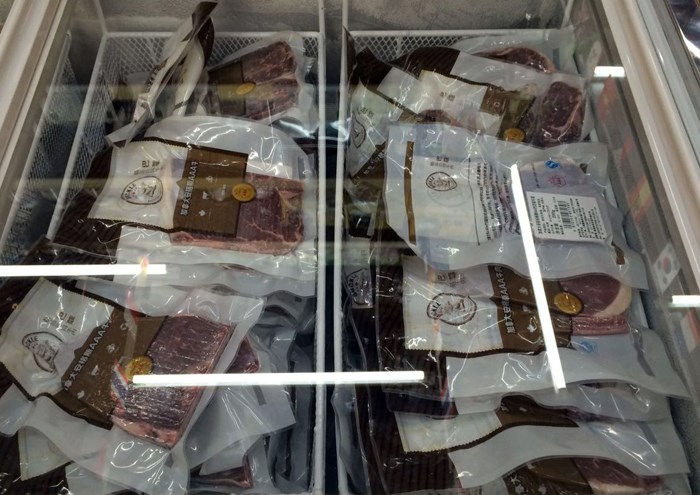It has taken four years of perseverance but today if you walk into select retailers in Shanghai, China you can purchase beef under the ‘Buckle Premium Canadian Beef’ brand logo.
The branded beef can be traced back to Yorkton-area beef producer Blaine Buckle a sixth generation cattle producer.
“We have fattened cattle as far back as the 1940s , and are now feeding 3000 head,” he said, adding he is also a part owner of three steakhouses, which is another connection to the cattle industry with a direct consumer link.
The branding initiative is a new thrust for Buckle, one he hopes will build a connection between the reputation Canada has a pristine source or high quality beef, and the Chinese consumer.
Buckle said gauging long term demand is almost impossible, but he does think there is potential.
“I think there will be, it just depends how we get through 2016,” he said.
Certainly the market is massive. Shanghai is the largest Chinese city by population, and the largest city proper by population in the world. It has a population of more than 24 million as of 2014, with the metro area population of some 34 million.
That said, to realize a return the beef has to sell at a premium. The equivalent of an eight-ounce steak selling for about three times what it would in Canada, said Buckle. However, in Canada where you would buy a steak for each person in a family of four, in China they buy one eight-ounce package of cubes, or strips for the family.
“Thanks to the branding as Canadian beef we can realize that extra return,” he said.
Still, it is a partnership of sorts with the stores in Shanghai, at present about 25 across the city selling his product under either the Buckle label, or that of the retail store.
“We’re relying on the retailers doing a good job of marketing,” he said.
While the market is finally stabilizing for Buckle, it hasn’t been an easy undertaking, with a few course changes and some definite hurdles to overcome.
In 2013 Buckle did a pilot project to feed a few cattle in northern China. He sent some equipment (including a feed mixer) over there and fed 100-head of cattle.
Buckle said the feeder animals were Simmental-influence, and while not of Canadian quality were not bad cattle.
Buckle said the idea of the trial was to see what a Canadian system might do in terms of feeding Chinese cattle.
The gains and conversion were not as good as here, but they were comparable, said Buckle.
However, when it came to the sale of the animals, Buckle said he quickly learned having the cattle there with few options left him exposed, and in the end the expected returns vanished.
So Buckle went at the Chinese market in a different fashion.
In 2014 through his company, he sent Canadian beef to China.
“We were the first company to legally export beef (Canadian) into mainland China,” he said.
The initial shipment was two containers of beef, “the equivalent of about 100-head of fat cattle,” said Buckle.
The beef was sent over frozen, boneless and in primal cuts and then further processed into strips, cubes and other various vacuumed packed sizes to meet consumer demand.
All the meat is also lab tested to Canadian Food Inspection Agency (CFIA) standards and CIQ (China’s CFIA) requirements, explained Buckle.
The beef went through a packing plant with the necessary licences to ship to China, he noted, adding if the market could be secured in the future he would like to work toward a licensed facility in Saskatchewan so that western Canadian beef was being sent.
Buckle said the process of getting the first containers of Canadian beef into China “was very hard,” but he added “we did the market research” ahead of the shipment to make sure they would not lose too much money if issues arose.
Part of the research help came from Saskatchewan’s trade office in Shanghai, said Buckle. A one person posting, he said the provincial presence was a lot of help in their planning, as was the support of Canada Beef Inc.
The initial success with the shipment raised hopes until a case of BSE (bovine spongiform encephalopathy) was discovered in Canada earlier this year sending a shudder through the beef sector, as China closed its borders to Canadian beef.
The closure was short-lived though and Buckle is again shipping beef, but he said they are once again having to build confidence with Chinese buyers.
“All of a sudden retailers were wondering if it might be a hit and miss situation in terms of the border being open, or not,” said Buckle.
Thankfully things have settled, and his product is moving steadily as needed now, allowing him to focus on building Chinese market demand.
Developing that demand was one of the reasons to move ahead with his own brand.
“It’s a fully integrated system,” said Buckle, noting the containers of beef arrive in Shanghai where they are further cut up by an independent processor under contract, packaged under the Buckle label and sent to select high-end import stores.
To ensure the quality is maintained Buckle employs a Quality Assurance Manager and a Marketing Manager to ensure their product quality is maintained.
At present about 50 per cent of the beef Buckle ships to China is marketed under his own label, the remainder sold under a store brand label.
Buckle said they are working on a project of 300 tonnes of beef shipping to Shanghai in 2016, which is the equivalent of 900-head of market animals. Further into the future he said a container a week (10 tonnes) is sort of a goal.
“We don’t know at this point what the potential is. We just don’t know,” he said. “… So far the feedback’s good.”




